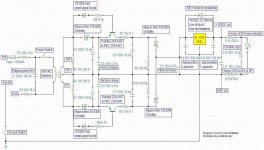I've been attempting to improve my $40 Entech Number Cruncher 203.2. According to my internet research, all the regular tweaking tricks have been attempted in modding this DAC but with very little success. The only two that seem to work best are changing the opa2134 opamp to AD8066 and implementing the "wildmonkeysects CS8412 loop filter" found over at AA.
One other area which I would like to explore is the power supply. I am thinking about upgrading the 16VAC wall-wart transformer to a 16VAC toroidal power supply which would be placed in an ABS enclosure with an IEC input connector, etc...
Do you think moving from a wall-wart to toroidal power supply would be worth the extra investment of time, talent, and treasure? In your experience, would more audio juice be squeezed into my ears?
One other area which I would like to explore is the power supply. I am thinking about upgrading the 16VAC wall-wart transformer to a 16VAC toroidal power supply which would be placed in an ABS enclosure with an IEC input connector, etc...
Do you think moving from a wall-wart to toroidal power supply would be worth the extra investment of time, talent, and treasure? In your experience, would more audio juice be squeezed into my ears?
I'm actually in the middle of re-housing three Entech's into a single enclosure and have built some new supplies for them.
I'm not a big believer of using a super large toroid for a DAC that only ever uses 6 watts of power max.
I figured the better thing to do was go with full-wave rectification using dual secondaries and two rectifiers. The transformers I'm using are 1.6VA, yes I said ONE-POINT-SIX VA, and thats plenty of power for this DAC. No crazy overkill there.
Here's a pic of one of the new supplies connected to the board when I was testing it.
http://i12.tinypic.com/2ui9nit.jpg
I'm not a big believer of using a super large toroid for a DAC that only ever uses 6 watts of power max.
I figured the better thing to do was go with full-wave rectification using dual secondaries and two rectifiers. The transformers I'm using are 1.6VA, yes I said ONE-POINT-SIX VA, and thats plenty of power for this DAC. No crazy overkill there.
Here's a pic of one of the new supplies connected to the board when I was testing it.
http://i12.tinypic.com/2ui9nit.jpg
peufeu said:With 1.6 watts, who needs transformers, you could even power it from solar cells for a nice clean power without mains hash !
Would make a nice complement to a planet-warming 100W class A monster...
Not sure if thats sarcasm or not.

The transformer is marked 18VAC @ 1.6VA x 2, but in use total power consumption is about 5-6w.
The DAC doesn't lack any bass or detail using this "flea powered" supply, so I don't understand why one would want to use an overrated toroid unless they just happen to have piles of them laying around.
Plenty of people build headphone/preamps that run off 9v batteries. Why are those considered OK to use such a small supply, but something like this supposedly needs some monsterous bundle of copper.

I believe the audible improvement is not actually as a result of available current from the bigger transformer but rather the lowering of the PSU impedance due to the thicker secondary windings of the larger transformer.
In the case of power amps it has to do with "stiffnes" of the supply and the lower impedance imo.
In the case of power amps it has to do with "stiffnes" of the supply and the lower impedance imo.
I can understand that point in regards to a power amp, but it doesn't make much sense to me when dealing with such a small load.
Wouldn't the net PSU impedance be effected by the filtering caps? If large enough low impedance caps are used wouldn't that help offset a trafo with a slightly higher impedance?
Wouldn't the net PSU impedance be effected by the filtering caps? If large enough low impedance caps are used wouldn't that help offset a trafo with a slightly higher impedance?
theAnonymous1 said:I can understand that point in regards to a power amp, but it doesn't make much sense to me when dealing with such a small load.
Wouldn't the net PSU impedance be effected by the filtering caps? If large enough low impedance caps are used wouldn't that help offset a trafo with a slightly higher impedance?
Hi.
The makers of a well known clock would disagree about the importance of the PSU. The 'Never-Connected' type power supply isolates the transformer from the load.
Andy
Attachments
mrdon said:Do you think moving from a wall-wart to toroidal power supply would be worth the extra investment of time, talent, and treasure? In your experience, would more audio juice be squeezed into my ears?
I did this for a Musical Fidelty X-CAN, which requires 12 Vac input for power. My situation is that I had purchased the unit in Spain, then discovered that a new walwart transformer would be required for operation in the USA. The cost of the new walwart was comparable to what I could put together on my own.
So, I went to Parts Express, and ordered a transformer (36VA, IIRC), parts for a dc blocker, fuse holder, power cords and cast aluminum enclosure. Works great.
One thing to watch on the transformer is to make sure that the regulation is adequate for the load you're going to use. Also, torroids can saturate easily if there is any dc on your ac power, such as from a light dimmer, so you might want to consider making a dc blocking circuit.
Regards,
Rob
- Status
- This old topic is closed. If you want to reopen this topic, contact a moderator using the "Report Post" button.
- Home
- Source & Line
- Digital Source
- Wall-wart to Toroid, worth the $$$?
